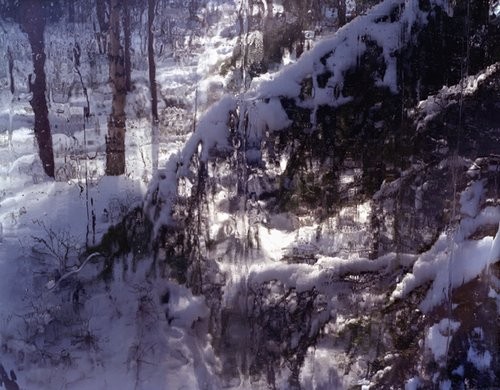Jorma Puranen
05 Feb - 08 Mar 2009
JORMA PURANEN
Sixteen Steps to Paradise 2007-2008
5.2. - 8.3.2009
In his new series of works Sixteen Steps to Paradise Jorma Puranen continues his treatment of light and shade. A familiar feature is also the use of reflections, which has continued since his series Shadows, Reflections and All That Sort of Thing consisting of photographs of painted portraits. For the artist, the use of reflections is a metaphor, a way to grasp the relationships of past and present, the issues of duration and recollection.
In the present works, Jorma Puranen depicts his immediate surroundings, a garden that he has partly tended himself. Sixteen Steps to Paradise, only sixteen steps from the doorstep. He creates photographs in which the temporal and sensory manifestations of the garden are the main theme. In Puranen’s almost hallucinatory images light and the deformed shapes of plants are exaggerated and unreal. Light, shade and air acquire almost material form in these works.
Gardens express sensitivity for things such as atmosphere and light, contemplation and melancholy. They also reflect the seasons, which together with the cycles of life and death distinguish the essence of the garden from other genres of art. Replete with beauty and even decay, Puranen’s photographs also pass on a strong sensation of deprivation and loss.
In Sixteen Steps to Paradise Jorma Puranen once again displays photographs in which reflections disturb their viewing. He reminds us that we look first at the photographs, reflections and shadows seen through optics, and only then at their subjects, the trees and plants. Photography is the art form that engages in the most expressive manner in a dialogue with the logic of light and shade. Moreover, Puranen manifests his confidence in the mystery by covering his subjects with light.
In Jorma Puranen’s latest work, the interspersing of the actual subject, its shadows and reflections, together with long exposure in the same photograph produces images that challenge the idea of a reference to reality that is so often associated with photography.
Sixteen Steps to Paradise 2007-2008
5.2. - 8.3.2009
In his new series of works Sixteen Steps to Paradise Jorma Puranen continues his treatment of light and shade. A familiar feature is also the use of reflections, which has continued since his series Shadows, Reflections and All That Sort of Thing consisting of photographs of painted portraits. For the artist, the use of reflections is a metaphor, a way to grasp the relationships of past and present, the issues of duration and recollection.
In the present works, Jorma Puranen depicts his immediate surroundings, a garden that he has partly tended himself. Sixteen Steps to Paradise, only sixteen steps from the doorstep. He creates photographs in which the temporal and sensory manifestations of the garden are the main theme. In Puranen’s almost hallucinatory images light and the deformed shapes of plants are exaggerated and unreal. Light, shade and air acquire almost material form in these works.
Gardens express sensitivity for things such as atmosphere and light, contemplation and melancholy. They also reflect the seasons, which together with the cycles of life and death distinguish the essence of the garden from other genres of art. Replete with beauty and even decay, Puranen’s photographs also pass on a strong sensation of deprivation and loss.
In Sixteen Steps to Paradise Jorma Puranen once again displays photographs in which reflections disturb their viewing. He reminds us that we look first at the photographs, reflections and shadows seen through optics, and only then at their subjects, the trees and plants. Photography is the art form that engages in the most expressive manner in a dialogue with the logic of light and shade. Moreover, Puranen manifests his confidence in the mystery by covering his subjects with light.
In Jorma Puranen’s latest work, the interspersing of the actual subject, its shadows and reflections, together with long exposure in the same photograph produces images that challenge the idea of a reference to reality that is so often associated with photography.

